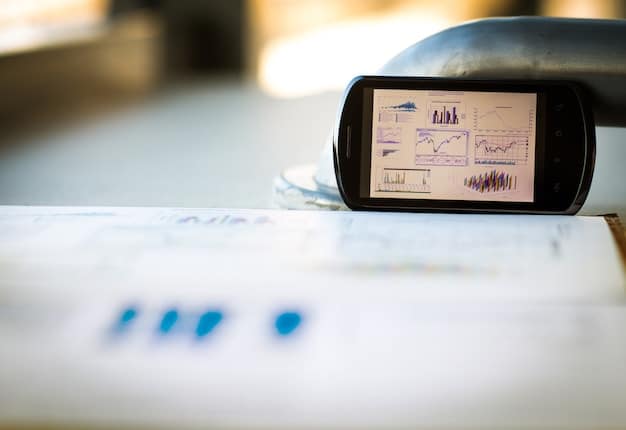Decoding 2025 Royalty Rates: A Guide for Independent Labels

Decoding the New Royalty Rates: A Guide for Independent Labels in 2025 provides a comprehensive overview of the evolving music industry compensation landscape, offering independent labels strategies for navigating these changes and securing fair deals.
Navigating the music industry’s financial landscape can be challenging, especially for independent labels. Decoding the New Royalty Rates: A Guide for Independent Labels in 2025 offers a clear roadmap to understanding and adapting to the evolving compensation structures, ensuring fair deals and sustainable growth.
Understanding the Current Royalty Landscape
The music industry has undergone a seismic shift in recent years, largely driven by the rise of digital streaming platforms. This transformation has significantly impacted how royalties are calculated and distributed, making it crucial for independent labels to stay informed.
Understanding the existing royalty rates is the first step in preparing for future changes. This involves knowing the different types of royalties and how they are generated.
Types of Royalties
There are several types of royalties that independent labels need to be aware of. These include:
- Mechanical Royalties: These are paid to the songwriter and publisher when a song is reproduced, whether physically or digitally.
- Performance Royalties: These are paid to the songwriter and publisher when a song is performed publicly, either live or via broadcast.
- Sound Recording Royalties: These are paid to the owner of the sound recording (typically the label) when a song is performed via digital services.
- Digital Performance Royalties: These are royalties paid for the digital performance of a sound recording, often collected and distributed by SoundExchange in the US.
Each type of royalty has its own set of rules and regulations, and understanding these nuances is essential for accurate accounting and revenue collection.
The challenge for independent labels is to navigate this fragmented system, ensuring they are capturing all the revenue streams available to them.
Key Changes Expected in 2025
As we look ahead to 2025, several significant changes are expected in the music industry, particularly concerning royalty rates. These shifts are largely driven by increasing scrutiny on fair compensation and the evolving dynamics of digital music consumption.
Anticipating these changes will help independent labels proactively adjust their strategies.
Legislative and Regulatory Updates
One area of significant change is the legislative and regulatory landscape. Several ongoing discussions and potential reforms could impact royalty rates.
These updates could include:
- The potential for increased mechanical royalty rates: Copyright Royalty Board (CRB) proceedings periodically review and adjust rates for statutory licenses, including mechanical royalties.
- Changes to the Digital Millennium Copyright Act (DMCA): Amendments to this act could affect how digital service providers handle copyright infringements and royalty payments.
- New regulations on data transparency: Increased pressure for digital services to provide more detailed data on music usage, which could lead to more accurate royalty calculations.
Staying abreast of these developments is crucial for independent labels to advocate for fair compensation and adapt to new legal requirements.
These regulatory changes are often complex, requiring labels to seek legal counsel to fully understand and comply with the new rules.

Strategies for Negotiating Fair Royalty Rates
Negotiation is a critical skill for independent labels. Securing favorable royalty rates often depends on a label’s ability to effectively negotiate with various stakeholders, including artists, publishers, and digital service providers.
Here are some strategies for negotiating fair royalty rates:
Understanding your leverage is key. Independent labels often have unique assets, such as niche audiences or innovative marketing strategies, which can be used as bargaining chips.
Building Strong Relationships
Cultivating strong, transparent relationships with artists and other stakeholders is essential for successful negotiations.
This involves:
- Open communication: Clearly communicate the label’s financial structure and royalty calculation methods.
- Fairness and transparency: Ensure that royalty agreements are fair and transparent, with clear accounting practices.
- Collaboration: Work collaboratively with artists to develop mutually beneficial agreements.
These relationships can lead to more favorable terms and long-term partnerships.
Building trust through transparent communication can prevent disputes and foster a healthy working environment.
Leveraging Technology for Royalty Tracking
In the digital age, technology plays a crucial role in accurately tracking and managing royalties. Independent labels can leverage various technological tools to streamline their royalty administration processes and ensure they are capturing all the revenue they are entitled to.
Effective royalty tracking not only ensures accuracy but also provides valuable insights into revenue trends.
There are several software solutions designed specifically for royalty tracking, offering features such as automated data collection, royalty calculation, and reporting.
These technologies can:
- Automate data collection: Automatically gather data from various digital platforms and sources.
- Streamline royalty calculations: Accurately calculate royalties based on agreed-upon rates and terms.
- Generate detailed reports: Provide comprehensive reports on royalty earnings, helping labels identify trends and opportunities.
Investing in these tools can significantly reduce administrative burdens and improve accuracy.
Cloud-based solutions offer the added benefit of accessibility and collaboration, allowing multiple team members to access and manage royalty data from anywhere.

The Role of Collective Management Organizations
Collective Management Organizations (CMOs) play a vital role in collecting and distributing royalties on behalf of rights holders. Independent labels need to understand how CMOs operate and how to effectively utilize their services.
CMOs act as intermediaries between music users and rights holders, ensuring that royalties are collected and distributed fairly.
Key CMOs and their functions include:
- ASCAP and BMI in the US: These organizations collect performance royalties for songwriters and publishers.
- SESAC in the US: Another performance rights organization that collects performance royalties.
- SoundExchange in the US: This organization collects digital performance royalties for sound recordings.
Joining these organizations can help independent labels ensure they are receiving all the royalties they are entitled to.
CMOs also provide valuable resources and support to their members, including legal advice and advocacy.
Future-Proofing Your Label: Preparing for 2025 and Beyond
The music industry is constantly evolving, and independent labels need to be proactive in preparing for future changes. This involves not only staying informed about royalty rates but also adopting strategies that will ensure long-term sustainability.
Diversifying revenue streams is one key strategy for future-proofing an independent label.
This can include:
- Expanding into new markets: Explore opportunities in emerging markets with growing music consumption.
- Developing innovative products and services: Offer unique merchandise, experiences, or subscription services.
- Leveraging direct-to-fan platforms: Build direct relationships with fans through platforms like Patreon or Bandcamp.
By diversifying their revenue streams, independent labels can reduce their reliance on traditional royalty models and build more resilient businesses.
Adapting to change requires a willingness to experiment and embrace new technologies and business models.
| Key Aspect | Brief Description |
|---|---|
| 🎵 Royalty Types | Understanding mechanical, performance, and sound recording royalties. |
| ⚖️ Legislative Updates | Staying informed on DMCA amendments and CRB proceedings. |
| 🤝 Negotiation | Building strong relationships for fair deals. |
| 🚀 Technology | Using tools for royalty tracking and detailed reporting. |
Frequently Asked Questions
▼
The main types include mechanical royalties (for reproduction), performance royalties (for public performance), sound recording royalties (for digital plays), and digital performance royalties (collected by entities like SoundExchange).
▼
Stay informed by monitoring Copyright Royalty Board (CRB) proceedings and potential amendments to the Digital Millennium Copyright Act (DMCA). Engage legal counsel to understand the impact and ensure compliance.
▼
Build strong, transparent relationships with artists and stakeholders, understand your label’s leverage, and communicate your financial structure clearly. Seek fair and collaborative agreements for mutual benefit.
▼
Technology automates data collection, streamlines calculations, and generates detailed reports. This ensures accuracy, reduces administrative burdens, and offers insights into revenue trends for informed decision-making.
▼
CMOs, like ASCAP, BMI, SESAC, and SoundExchange, collect and distribute royalties on behalf of rights holders. Joining these organizations ensures independent labels receive their entitled royalties and offers valuable resources and support.
Conclusion
Decoding the complexities of royalty rates in 2025 requires independent labels to stay informed, leverage technology, and build strong relationships. By understanding the evolving landscape and adopting proactive strategies, labels can ensure fair compensation and long-term sustainability in the music industry.





